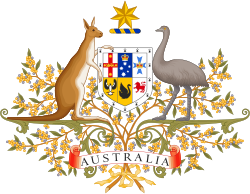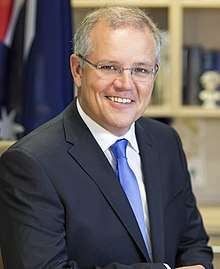Prime Minister's Office (Australia)
The Prime Minister's Office (PMO), also known as the Office of the Prime Minister, is the private office of the Prime Minister of Australia which provides political advice and executive support to the Prime Minister.[5][6] The PMO is led by the Prime Minister's Chief of Staff and or Principal Private Secretary and is composed of party advisers, media specialists, and political strategists.[7] Scholars including Professor Anne Tiernan of Griffith University and Professor James Walter of Monash University have observed the centralisation and expansion of power within the PMO over the past three decades.[8][9]
| Prime Minister of Australia | |
|---|---|
 | |
| |
| Style |
|
| Member of | |
| Reports to | Parliament, Governor-General |
| Residence | |
| Seat | Canberra |
| Appointer | Governor-General of Australia by convention, based on appointee's ability to command confidence in the House of Representatives[2] |
| Term length | At the Governor-General's pleasure contingent on the Prime Minister's ability to command confidence in the lower house of Parliament[3] |
| Inaugural holder | Edmund Barton |
| Formation | 1 January 1901 |
| Deputy | Michael McCormack |
| Salary | $549,229 (AUD) annually[4] |
| Website | pm |
The PMO should not be confused with the Department of the Prime Minister and Cabinet which is a public service entity that provides non-political policy coordination and executive support for the Prime Minister and Cabinet's agenda or with the Prime Minister's official residences at The Lodge and Kirribilli House.
History
The origins of the contemporary Prime Minister's Office can be found with Prime Minister Malcolm Fraser who cemented the central authority of the Prime Minister through an adviser structure.[10] Prime Ministers Bob Hawke and Paul Keating also continued to expand the role and size of the Prime Minister's Office through the coordination of the development and implementation of the government's agenda. Prime Minister John Howard further expanded and centralised power within the PMO.[11][12]
Roles and activities
The role of the Prime Minister's Office has changed over time but has consistently been a source of political advice for the Prime Minister of the day.[13]
Structure and staff
The organisational structure and staffing arrangements of the Prime Minister's Office changed with the personal preferences, political interests, and strategic priorities of the Prime Minister of the day.[14] Nevertheless, there has been the trend of the increasing size of the PMO since the Hawke and Keating Governments. Traditionally, the two key positions within the PMO have been the Chief of Staff and the Principal Private Secretary.[15] The PMO also seconds Departmental Liaison Officers from the Department of the Prime Minister and Cabinet to enable engagement for the flow of advice, correspondence, submissions and other communications to and from the PMO and PM&C.[16]
Chiefs of Staff
The position of Chief of Staff to the Prime Minister of Australia was formally created by Prime Minister Gough Whitlam in 1972 to run the political and private office of the Prime Minister.[17][18]
List of Chiefs of Staff
- Peter Wilenski (Chief of Staff to Prime Minister Gough Whitlam)
- Tony Eggleton (Chief of Staff to Prime Minister Malcolm Fraser)
- David Kemp (Chief of Staff to Prime Minister Malcolm Fraser 1981)
- Sandy Hollway (Chief of Staff to Prime Minister Bob Hawke 1988-1990)
- Dennis Richardson (Chief of Staff to Prime Minister Bob Hawke 1990-1991)
- Don Russell (Chief of Staff to Prime Minister Paul Keating 1991-1993)
- Allan Hawke (Chief of Staff to Prime Minister Paul Keating 1993-1996)
- Nicole Feely (Chief of Staff to Prime Minister John Howard 1996-1997)
- Grahame Morris (Chief of Staff to Prime Minister John Howard 1997)
- Arthur Sinodinos (Chief of Staff to Prime Minister John Howard 1997-2006)
- David Epstein (Chief of Staff to Prime Minister Kevin Rudd 2006-2008)
- Alister Jordan (Chief of Staff to Prime Minister Kevin Rudd 2008-2010)
- Amanda Lampe (Chief of Staff to Prime Minister Julia Gillard 2010-2011)
- Ben Hubbard (Chief of Staff to Prime Minister Julia Gillard 2011-2013)
- Peta Credlin (Chief of Staff to Prime Minister Tony Abbott 2013-2015)
- Drew Clarke (Chief of Staff to Prime Minister Malcolm Turnbull 2015-2017)
- Greg Moriarty (Chief of Staff to Prime Minister Malcolm Turnbull 2017)
- Peter Woolcott (Chief of Staff to Prime Minister Malcolm Turnbull 2017-2018)
- John Kunkel (Chief of Staff to Prime Minister Scott Morrison 2018-ongoing)
Principal Private Secretary
Prior to the formalisation of the Prime Minister's Chief of Staff in 1972, the Prime Minister's Office was traditionally headed by a career public servant known as the Principal Private Secretary. The position of Principal Private Secretary functioned as a Chief of Staff and has been responsible for the management of relationships and stakeholders at the direction of the Prime Minister.[19][20]
List of Principal Private Secretaries
- Frank Jennings (Principal Private Secretary to Prime Minister Robert Menzies 1963-1966)
- Frank Jennings (Principal Private Secretary to Prime Minister Harold Holt 1966-1967)
- Ian Grigg (Principal Private Secretary to Prime Minister William McMahon 1971-1972)
- Peter Wilenski (Principal Private Secretary to Prime Minister Gough Whitlam 1972)
- Dale Budd (Principal Private Secretary to Prime Minister Malcolm Fraser 1975-1978)
- Graham Evans (Principal Private Secretary to Prime Minister Bob Hawke 1983-1986)
- Chris Connybeare (Principal Private Secretary to Prime Minister Bob Hawke 1986-1988)
- Sandy Hollway (Principal Private Secretary to Prime Minister Bob Hawke 1988-1990)
- Dennis Richardson (Principal Private Secretary to Prime Minister Bob Hawke 1990–1991)
- Sally Cray (Principal Private Secretary to Prime Minister Malcolm Turnbull 2015-2017)
- Yaron Finkelstein (Principal Private Secretary to Prime Minister Scott Morrison 2018-ongoing)
In popular culture
The Prime Minister's Office was satirised in the television comedy series The Hollowmen which centred on the fictitious Central Policy Unit inspired by the Cabinet Policy Unit established by Prime Minister John Howard.[21]
See also
References
- "Heads of State, Government and Ministers for Foreign Affairs" (PDF). UN. United Nations Foreign and Protocol Service.
- Australia's Constitution : With Overview and Notes by the Australian Government Solicitor (Pocket ed.). Canberra: Parliamentary Education Office and Australian Government Solicitor. 2010. p. v. ISBN 9781742293431.
- "9 - Motions". House of Representatives Practice, 6th Ed – HTML version. Parliament of Australia. Retrieved 23 February 2018.
- Maiden, Samantha (6 June 2019). "Scott Morrison gets $11,000 pay rise on the day workers lose penalty rates". The New Daily.
- [The Gatekeepers: Lessons from prime ministers’ chiefs of staff] RAW Rhodes and Anne Tiernan. Melbourne University Press 2014
- The Pivot of Power: Australian Prime Ministers and Political Leadership, 1949–2016 Museum of Australian Democracy at Old Parliament House
- [The Gatekeepers: Lessons from prime ministers’ chiefs of staff] RAW Rhodes and Anne Tiernan. Melbourne University Press 2014
- The Pivot of Power: Australian Prime Ministers and Political Leadership, 1949–2016 Museum of Australian Democracy at Old Parliament House
- The Role of Executive Government in Australia Don Russell. Papers on Parliament No. 41 December 2003
- The Role of Executive Government in Australia Don Russell. Papers on Parliament No. 41 December 2003
- Advising Howard: Interpreting Changes in Advisory and Support Structures for the Prime Minister of Australia Anne Tiernan, Australian Journal of Political Science Vol. 41, No. 3, September, pp. 309–324
- The Pivot of Power: Australian Prime Ministers and Political Leadership, 1949–2016 Museum of Australian Democracy at Old Parliament House
- The Pivot of Power: Australian Prime Ministers and Political Leadership, 1949–2016 Museum of Australian Democracy at Old Parliament House
- [The Gatekeepers: Lessons from prime ministers’ chiefs of staff] RAW Rhodes and Anne Tiernan. Melbourne University Press 2014
- The ultimate insiders' job [[Sydney Morning Herald
- The Prime Ministers’ Chiefs The Wheeler Centre 2014
- Museum of Australian Democracy at Old Parliament House
- The Prime Ministers’ Chiefs The Wheeler Centre 2014
- Staff Office, Prime Minister’s Suite — M94.6 Museum of Australian Democracy at Old Parliament House
- The Hollowmen Sydney Morning Herald
Further reading
- Rhodes, R.A.W.; 't Tiernan, Anne (2014). The Gatekeepers: Lessons from prime ministers’ chiefs of staff. Melbourne University Press. ISBN 9780522866513.CS1 maint: ref=harv (link)
- Strangio, Paul; 't Hart, Paul; Walter, James (2016). Settling the Office: The Australian Prime Ministership from Federation to Reconstruction. Melbourne University Press. ISBN 9780522868722.CS1 maint: ref=harv (link)
- Strangio, Paul; 't Hart, Paul; Walter, James (2017). The Pivot of Power: Australian Prime Ministers and Political Leadership, 1949-2016. Melbourne University Press. ISBN 9780522868746.CS1 maint: ref=harv (link)
External links
| Library resources about Prime Minister's Office (Australia) |
